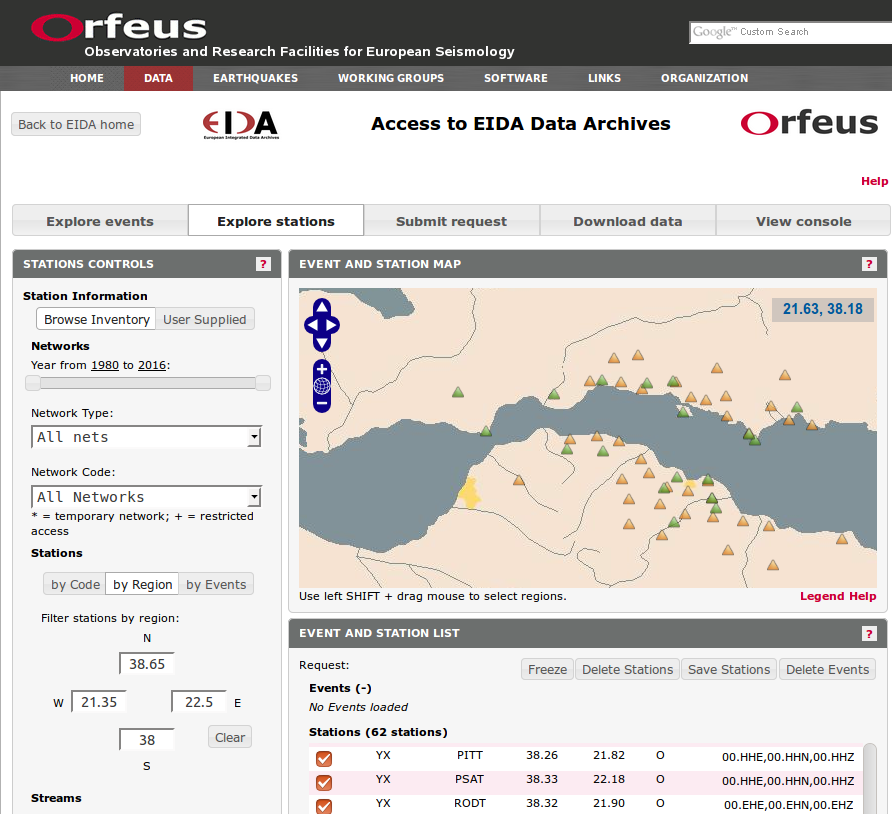Catégorie : Seismology
Moment tensor
Focal mechanisms
Earthquakes parameters
Seismic phase onset
Accelerometer Seismic Waveforms Continuous
Trigerred stations
Others:
Visit the Corinth Gulf Soft Soil Array (CORSSA) data-base. This was an array of accelerometers operated from June 2002 to May 2012, with surface and downhole sensors installed in the vicinity of Aigion. Reference: Kassaras I., Roumelioti Z., Ktenidou O.J., Pitilakis K., Voulgaris N., Makropoulos K., 2016, Accelerometric data and web portal for the vertical Corinth Gulf Soft Soil Array (CORSSA), 14th International Congress of the Geological Society of Greece, Thessaloniki, 2016
Velocimeter Seismic Waveforms Continuous
The seismological arrays
Strong motion network (continuous & triggered)
 Continuous NOA station
Continuous NOA station Triggered NOA station
Triggered NOA station Continuous CNRS station
Continuous CNRS station Triggered ITSAK station
Triggered ITSAK station
See also the EuroSeisTest data base
Seismic network. Objective: high resolution continuous monitoring of the seismicity in the Aigion-Patras area

 U. of Athens station
U. of Athens station NOA station
NOA station CNRS station
CNRS station U. of Patras station
U. of Patras station
Network description
- CRLNET is composed of 11 stations equipped with 2Hz seismometers, 9 stations equipped with broad band seismometers, recording continously at 100 Hz and one antenna of 7 broad band stations. CNRS (France) is running 14 stations and the antenna, Patras University 4 stations and Athens University 2.
- 5 seismometers on the south shore of the gulf are in 60-100 m deep boreholes (AIOA, ALIK, AGEO,DIMT, TEME). MALA located on the Mornos delta on the north shore is in a 190 m deep borehole.
- All stations are transmitted in real time and merged to provide real time earthquake location.
- Data are available since April 2000.
- View real time recordings
- View real time locations
- Access revised automatic catalogs and seismicity maps
- Access CUP (Charles University of Prague) database
Acces to waveform data
- The seismological/deformation network is operated by different institutions and therefore associated with different network codes. The present configuration is :
- code HP : SERG, ANX, PVO, EFP, VVK ; doi:10.7914/SN/HP ; University of Patras
- code HA : LAKA, KALE ; doi:10.7914/SN/HA ; Kapodastrian University of Athens
- code HL : KLV, RLS, DLFA ; doi:10.7914/SN/HL ; National Observatory of Athens
- code CL : all CNRS stations ; doi: 10.15778/RESIF.CL ; Citing instructions are given in ; Centre National de La Recherche Scientifique
- A virtual network code _NFOCRL is maintained at EIDA-NOA data center and includes all stations located inside the large frame of CRL Laboratory. A global request can be done using this virtual network code. Attention : presently only the ArcLink procedure is operational at NOA server (eida.gein.noa.gr:18001) for the virtual network code, FDSN web services will be operational in the future.
Data are archived at:
– NOA data center for the HP, HA, HL network codes.
– RESIF data center for the CL network code.
- Real time and quality controled data are available on EIDA european servers. This concerns all velocity and acceleration chanels. Soon deformation and tide gauge will be added.
- Requests tools are the classical tools of the seismological community :
– Near real time data with seedlink at rtserve.resif.fr (TCP port 18000) for CL data. Documentation
– Arclink node :eida.resif.fr (TCP port 18001) or eida.gein.noa.gr (TCP port 18001). Documentation
– FDSN web services at ws.resif.fr/fdsnws (TCP port 80) or eida.gein.noa.gr/fdsnws/ (TCP port 80). Documentation
– Web tool at eida.gein.noa.gr/webdc3/ or Orfeus data center.
Data before 2010 are progressively added to the database. All HA and HP stations with the _NFOCRL will be progressively added in EIDA@NOA. CL data between 2000 and 2010 are added progressively to the RESIF database. CL real time data are qualified and completed when possible within a delay of one year.
CONTACTS:
H. Lyon-Caen or A. Deschamps for CR@NFOCRL
C. Evangelidis for HL@NFOCRL
E. Sokos or J. Zahradnik for HP@NFOCRL
P. Papadimitriou for HA@NFOCRL


